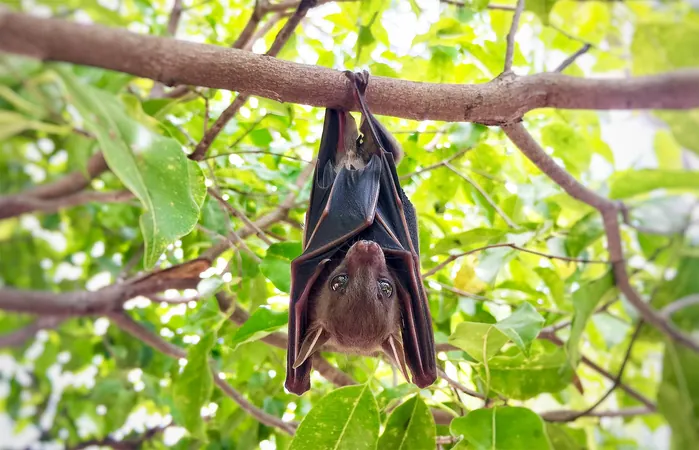
Bats Hold the Secret to Longevity: Why They Don't Get Cancer and Live Longer Than Dogs!
2025-06-15
Author: Wei
In an astonishing twist of nature, tiny bats, weighing less than an ounce, frequently outlive larger mammals like German shepherds, boasting lifespans that can reach up to 35 years in the wild—equivalent to nearly 180 human years. Even more remarkable is their extraordinary resistance to tumors, leaving scientists eager to uncover the reasons behind their exceptional health.
Unveiling Bat Longevity: A Scientific Investigation
A groundbreaking study by a team at the University of Rochester delves into the genetic secrets of four bat species, revealing a complex interaction between a powerful tumor suppressor gene, self-renewing chromosomes, and a uniquely balanced immune system. Led by researchers Vera Gorbunova and Andrei Seluanov, this research provides insights into why bats thrive beyond typical aging patterns.
Defying Cancer: Bats vs. Aging
Cancer risk tends to heighten as mammals age due to increased chances of DNA damage—a phenomenon known as Peto’s paradox. However, bats are an outlier, having independently developed extreme longevity across four different lineages. The study highlights that the little brown bat (Myotis lucifugus) possesses not one, but two effective copies of the key tumor suppressor gene p53, unlike humans who carry just a single version.
Gorbunova explains, "High levels of p53 can eliminate cancer cells before they can become harmful through a process known as apoptosis."
Meet the Little Brown Bat
Commonly seen across North America, the little brown bat is a small but mighty insectivore, capable of consuming hundreds of mosquitoes in a single night. These bats roost in cozy, dark places like attics and trees and hibernate in colonies during winter. Tragically, their populations are declining due to white-nose syndrome, a deadly fungal disease, prompting major conservation efforts.
The Power of p53 in Bats
While p53 duplication isn’t exclusive to bats—elephants also boast multiple copies—bats achieve a perfect balance of this gene to eliminate precancerous cells without harming healthy ones. With bat cells requiring only two genetic alterations to become cancerous—far fewer than human cells—this efficient p53 mechanism can swiftly signal rogue cells to self-destruct.
Chromosome Secrets: Telomeres at Play
Bats maintain long chromosome tips known as telomeres, aided by an enzyme called telomerase, defying age-related shortening. Previous studies showed that telomeres in Myotis bats remain intact with age, supporting tissue regeneration without leading to crises. While excessive telomerase can cause tumors in other species, bats utilize heightened p53 activity to eliminate rogue cells during rapid cell divisions.
Bats' Unique Immune Defense
Bats also possess a highly efficient immune system that quickly detects threats while restraining inflammation, which can foster cancer in aging tissues. By dampening the NLRP3 inflammasome and regulating type I interferon responses, bats can effectively eliminate viruses and damaged cells without inflicting collateral damage on surrounding tissues.
Lessons for Cancer Treatment
The implications of the bat research for human health are profound. Experimental treatments aimed at enhancing p53 activity in resistant tumors and reactivating telomerase in aging tissues could hold the key to tackling cancer and promoting healthy longevity. This study, funded by the National Institute on Aging, addresses two critical areas: enhancing lifespan and preventing cancer.
What Other Animals Can Teach Us
The quest for understanding longevity doesn't stop with bats. Animals like naked mole rats, bowhead whales, and elephants each have unique methods for cancer resistance, broadening our understanding of disease prevention. Bats now join this elite group, offering insights into managing cellular risks while enabling the body to grow and age gracefully.
The research findings, published in Nature Communications, lay the groundwork for potentially transformative therapies that could leverage the extraordinary biological traits of bats to improve human health.



 Brasil (PT)
Brasil (PT)
 Canada (EN)
Canada (EN)
 Chile (ES)
Chile (ES)
 Česko (CS)
Česko (CS)
 대한민국 (KO)
대한민국 (KO)
 España (ES)
España (ES)
 France (FR)
France (FR)
 Hong Kong (EN)
Hong Kong (EN)
 Italia (IT)
Italia (IT)
 日本 (JA)
日本 (JA)
 Magyarország (HU)
Magyarország (HU)
 Norge (NO)
Norge (NO)
 Polska (PL)
Polska (PL)
 Schweiz (DE)
Schweiz (DE)
 Singapore (EN)
Singapore (EN)
 Sverige (SV)
Sverige (SV)
 Suomi (FI)
Suomi (FI)
 Türkiye (TR)
Türkiye (TR)
 الإمارات العربية المتحدة (AR)
الإمارات العربية المتحدة (AR)